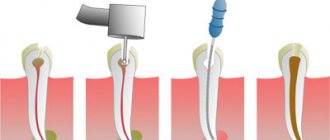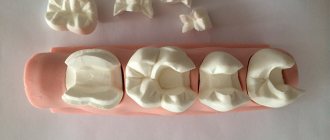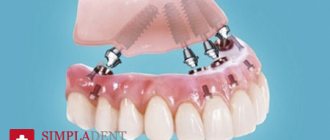Anesthesia or local anesthesia in dentistry allows you to treat teeth without pain, which provides comfort for the patient and ease of work for the dentist.
Local anesthesia only acts on a limited area and is usually administered by the dentist himself.
Currently, dental treatment without anesthesia is nonsense. Modern medical standards require not only high-quality, but also the most comfortable and painless treatment for the patient. The dentist individually decides how and with what drugs to treat pain, taking into account the amount of work, area, depth and individual characteristics of the patient.
Many of us often delay visiting the dentist because... They have been afraid of them since childhood, but “advanced” caries can cause serious complications that may even require surgical intervention. The smaller the destruction and the earlier the patient consulted a doctor, the better, faster and less painful the treatment can be.
Dentists strongly recommend not to delay your visit. Tooth decay is more dangerous than you think. Possible consequences:
- pulpitis and periodontitis;
- diseases of the cardiovascular system and joints, because caries is a source of infection;
- chronic allergic reactions;
- if the tooth is completely destroyed, this will affect the quality of chewing food and, as a result, may lead to gastrointestinal diseases
Prices for tooth extraction at Apex-D dentistry
| Name | rub. |
| Opening an abscess | 500 |
| Abscess drainage | 350 |
| Removal of a single root tooth | 2000 |
| Removal of a double-rooted tooth | 2500 |
| Removal of a three-root tooth | 3000 |
| Removal of the third molar “wisdom tooth” of the upper jaw | 3000 |
| Removal of the third molar “wisdom tooth” of the lower jaw | 3500 |
| Root separation | 350 |
| Hemisection | 1500 |
| Osteotomy | 1500 |
| Socket curettage | 300 |
| Tamponade with iodoform turunda | 300 |
| Alvaugille | 300 |
| Neocones | 300 |
| Stitching | 750 |
| Periostotomy | 500 |
| Hemostasis | 200 |
| Cystectomy | 3000 |
| Cystectomy with resection of the apex of one root, frontal group | 4500 |
| Cystectomy with resection of the apex of one root, chewing group | 5500 |
| Cystectomy, resection of each subsequent apex | 1500 |
| Cystotomy | 1500 |
| Cyst removal | 1000 |
| Closed curettage | 1000 |
| Open curettage of one tooth area | 1500 |
Modern dental practice makes it possible in most cases to prevent tooth extraction. The doctor’s rule is to prescribe tooth extraction surgery only as a last resort, when all available treatment methods have been tried and it is no longer possible to save the tooth, or in the event that the problematic tooth is the cause of the development of more serious complications.
Medications to relieve fear and anxiety before visiting the dentist
There are many sedatives that reduce anxiety, one of which is Afobazole. This drug does not have a hypnotic effect, however, for positive results, you should start drinking it a week before the expected visit to the dentist.
Cheaper drugs (Corvalol, valerian extract, etc.) should be started three days before visiting the doctor, but these drugs in high doses can lead to weakness, drowsiness and decreased performance.
Also, in many clinics you can be given premedication - the administration of sedatives intramuscularly half an hour before dental procedures. Such drugs are classified as tranquilizers and are available by prescription (Seduxen, Relanium, etc.).
What are the indications for tooth extraction?
Before tooth extraction surgery, the doctor prescribes an x-ray examination; the resulting images help assess the condition of diseased teeth.
- Detection of chronic periodontitis at the acute stage, when it is impossible to eliminate the source of inflammation in the area of the apex of the tooth using therapeutic methods
- In order to prevent the development of more serious complications
- Diagnosis of basal (near-root) tooth cyst
- Presence of inflammation or trigeminal neuritis
- If a problematic tooth constantly injures the mucous membrane of the tongue or cheeks
- If a tooth puts pressure on adjacent teeth, injuring their roots, which leads to bone resorption
- If a problematic tooth disrupts the normal bite and displaces neighboring teeth
- Multi-rooted teeth that have caused odontogenic osteomyelitis must be removed
- Sometimes the doctor prescribes tooth extraction to fit a removable denture
- With severe destruction by carious lesions
- If the tooth has not fully erupted and has an incorrect angle
- Due to progressive periodontal disease
- Due to an injury that resulted in a tooth fracture beyond repair
- If the teeth are in an incorrect position in the dentition (this situation is often detected during the eruption of wisdom teeth)
Subsequently, the removal of a tooth causes a gradual displacement of adjacent teeth; with prolonged absence of a tooth, this can lead to significant impairment of chewing function and noticeable deformation of the entire dentition. In order to prevent such complications, it is recommended to restore the extracted tooth by replacing it with an artificial one.
Modern dental practice has wide capabilities in the field of operative surgery and implantology, due to which replacing a defect in the dentition by installing a dental implant is the most natural and preferable; depending on the clinical situation, the modern patient has access to the latest technologies for the manufacture of dental bridges or removable partial dentures.
The effectiveness of local anesthesia
The success of deep anesthesia depends on the anesthetic, the concentration of the vasoconstrictor, the type of anesthesia, the dose of the drug, the qualifications of the dentist and the individual response of the patient. 4% articaine with an adrenaline concentration of 1:100000 is the most effective. Conduction anesthesia provides better pain relief than infiltration anesthesia, but requires a more highly qualified doctor. (However, even the most experienced specialists have a certain percentage of failures). The patient's agitated panic state and prolonged pain tolerance for several days before the visit reduce the effectiveness of local anesthesia. Alcohol and drugs - even more so.
Possible complications after tooth extraction
After simple extraction of any tooth, complications occur quite rarely, provided that the doctor’s recommendations are followed.
The main thing is that the patient needs to remember that if the blood clot remains in the socket until healing, then infection and suppuration of the wound will not occur, and within two weeks a healthy gum mucosa will appear at the site of the clot. In case of loss of a blood clot, the unprotected wound surface of the socket is exposed to pathogenic microflora of the oral cavity; the accumulation of pathogenic bacteria provokes the development of an inflammatory process - alveolitis.
Infection of the alveolar socket is the most common complication after tooth extraction. In this case, the infection penetrates and affects the soft tissues surrounding the tooth. If an infectious infection of the hole is accompanied by the presence of throbbing pain and suppuration, this signals the development of an abscess. When alveolitis is advanced, there is a danger of the inflammatory process spreading to the jaw bone - the development of osteomyelitis.
Complex (traumatic) tooth extraction has more prerequisites for the development of inflammatory complications. If after removal there remains a piece of tooth infected with caries, curettage of the hole and extraction of the tooth fragment will be required.
Also, after a complex removal, there is a possibility of delayed bleeding, several hours after the operation. The causes of such bleeding can be high blood pressure, severe stress, the body's reaction to certain medications, excessive rinsing and irritation of the wound with hot food.
In rare cases, the nerve trunks of the lower jaw may be damaged during surgery. Simple or complex tooth extraction is an unpleasant operation, but there is no point in postponing a visit to the doctor if the tooth causes discomfort and pain, most likely its removal is only a matter of time. Modern ultrasonic removal of teeth on the upper or lower jaw will save you from unwanted consequences and many troubles associated with the onset of complications after surgery.
Incorrect position of the wisdom tooth in the row
When a wisdom tooth takes an incorrect position during growth or is partially erupted, pericoronitis (inflammation of the tissues around the tooth) often develops, this is due to the fact that part of the tooth remains in the gum, and the formed periodontal pocket covering the tooth is difficult to clean from food debris , which accumulate and create an environment favorable for the development of pathogenic microflora.
A common disease of wisdom teeth is caries, since food particles remain in the interdental space with the adjacent tooth due to difficult access for cleaning, and plaque forms on the teeth. In this case, carious destruction spreads to the adjacent second molar.
Doctors recommend removing wisdom teeth if they have partially erupted or are incorrectly positioned in the dentition as early as possible, before complications occur and before their roots are fully formed.
Removal of impacted wisdom tooth
Defects in the development of third molars are caused by injury and destruction of the wisdom tooth itself and, if it puts pressure on the adjacent tooth, it damages the roots and surrounding tissues. This situation is observed due to improper growth, damage by caries, often inaccessible to treatment, surfaces of the wisdom tooth with the formation of a focus of infectious inflammation. These complications diagnosed by a doctor are absolute indications for tooth extraction.
This includes the removal of an impacted (unerupted) figure eight, when the tooth failed to erupt and remained embedded in the gum or bone.
Immersion may be tissue if the tooth has passed through the bone but is unable to penetrate the gum tissue, or bone if the tooth remains completely in the jawbone.
Follicular cyst of wisdom tooth
The formation of a follicular cyst can be asymptomatic, but the appearance of pain and high temperature already signals its active development and the presence of an inflammatory process. An increase in the size of a follicular cyst is dangerous due to the thinning of the jawbone tissue due to its replacement with a new growth.
Also, impacted and semi-impacted (partially erupted) figure eights are indicated for removal, since remaining covered by a large layer of dense mucous membrane, they put pressure on the surrounding soft tissues.
Prolonged injury to the mucous membrane from the inside contributes to the formation of pathogenic microflora. The appearance of redness, pain, and swelling indicates the occurrence of an inflammatory process, pericoronitis.
Simple tooth extraction
Simple tooth extraction, including wisdom teeth, is in most cases permissible in the upper jaw, which has a looser and softer structure and allows the tooth to be successfully grasped with forceps. If the tooth has fused roots and can be rocked, then its removal will not be difficult.
Simple removal of a wisdom tooth in the upper jaw can be done with little resistance.
Complex tooth extraction
The anatomy of the lower jaw itself prevents not only the eruption of third molars without complications, but also complicates the process of wisdom tooth extraction.
Difficult tooth extraction from below is due to the fact that the mandibular bone has a denser and stronger structure, and the roots of such teeth in the lower jaw are often curved and may have several processes, which complicates their smooth removal.
Bent or damaged roots of the eighth tooth below or above and its incorrect location, including complete or partial immersion in bone tissue, create a serious obstacle to its extraction. This situation is non-standard and requires labor-intensive efforts to remove wisdom teeth in difficult conditions. To provide quick access to the area where the tooth is located, the surgeon cuts the gum and periosteum.
During such an operation, it is possible to drill out a certain amount of bone covering the tooth or extract the problematic tooth in parts.
Ultrasound removal of wisdom teeth
At the Apex-D Dental Implantation Clinic, wisdom teeth are removed using an ultrasonic instrument.
Ultrasound surgery allows the removal of wisdom teeth, especially in complex cases, in the most atraumatic way.
The use of ultrasound in dental surgery makes it possible to perform surgery in extremely hard-to-reach places, minimize trauma to the soft and bone tissues surrounding the tooth, reduce the likelihood of complications after surgery and speed up the healing of the wound surface of the socket after tooth extraction.
Questions and answers on this topic: Tooth extraction, wisdom teeth removal
You can make an appointment at Apex-D Dentistry by calling the administrator at +7 and +7, or filling out an electronic form (the administrator will contact you at the specified phone number and agree on the date and time of the appointment).
Instruments for local anesthesia
The injection requires a syringe, a needle and a local anesthetic solution.
For several decades now, in dentistry, instead of disposable syringes, a reusable carpule syringe has been used. A disposable anesthetic cartridge and a disposable needle are inserted into it. They are used once, and the metal syringe itself is sterilized after each patient. Reuse of an incompletely used carpule is prohibited, since during the injection a reverse flow of blood or other liquid through the needle into the carpule is possible (there is a risk of infection of the next patient).
A special syringe gun is available for intraligamentary anesthesia. The same needles and carpules are inserted into it as into a carpule syringe. It allows you to more accurately dose the volume of anesthetic for a given type of anesthesia (but it is also possible to perform intraligamentary anesthesia with a regular carpule syringe).
The thickness of the needles used in carpule syringes is 0.3-0.5 mm. This is much thinner than disposable syringes (therefore the injection is much less painful). Length – 8-30 mm. For mandibular and torusal anesthesia, longer and thicker needles are used than for infiltration. To carry out intrapulpal and intraligamentary anesthesia, the needle can be bent (it does not break).
Carpula is a sealed glass cartridge with a rubber plunger. In dentistry, in most cases, the anesthetic solution, in addition to the anesthetic drug itself, contains a vasoconstrictor - a vasoconstrictor component that prevents the rapid elimination of the anesthetic through the general bloodstream. This is adrenaline (epinephrine). Its concentration is negligible - 1:100000 or 1:200000. When manually drawing such a mixture into a disposable syringe, add 1 drop of adrenaline to the anesthetic solution. However, the size of a drop is such a relative value that the concentration of this very active component can differ tens of times in different syringes. This creates many complications, even life-threatening situations for the patient.
The introduction of carpules with precise industrial dosages of components has greatly reduced the number of such complications. However, it should be noted that different manufacturers have different attitudes towards maintaining strict dosages of their own carpules. For the product of the Russian pharmaceutical industry, Brilocaine (manufacturer: Bryntsalovskiy Ferein), the anesthetic effect of two capsules from one package can be radically different: from complete absence of pain relief to super strong (“my legs froze,” according to the patient). Although the packaging states exactly the same ingredients as imported Ultracain, Ubistezin or Septanest.
Xenon sedation or xenon therapy to prepare for main anesthesia
This is a separate type of anesthesia that can be used in combination with both local and general anesthesia (if necessary). Xenon is an inert gas that quickly begins to act and is just as quickly eliminated from the body. It has a relaxing effect: anxiety decreases, the patient relaxes. Moreover, during the operation he is fully conscious, can communicate with the doctor, and understands everything that is happening around him. The procedure can be interrupted if necessary if there is discomfort. At the same time, local anesthetics are used, since xenon itself does not have a pronounced analgesic effect.
Among the pleasant “bonuses” are saturation of cells with oxygen and restoration of metabolic processes. That is, this is not only a reduction in stress, but also a general improvement in the body’s health.










